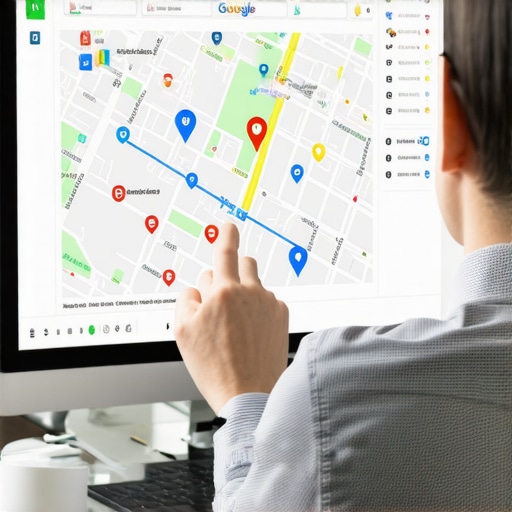Unveiling the Complexity of Maps SEO in 2024: A Strategic Perspective
In the rapidly evolving landscape of local search, understanding the nuanced mechanics of Google Maps SEO is paramount for professionals seeking to dominate local visibility. The convergence of user intent, algorithmic shifts, and technological innovations demands a sophisticated, layered approach. This article explores proven strategies that leverage semantic SEO principles, technical optimization, and user experience enhancements to secure top rankings in 2024.
How Do Search Intent and Local Context Drive Maps SEO Success?
At the core of effective Maps SEO lies an intricate understanding of search intent, especially in local queries. Advanced practitioners analyze not only keyword relevance but also contextual signals such as user location, device type, and behavioral patterns. Integrating these factors into your optimization strategy ensures your business appears in the right place, at the right time, with the right message. For instance, optimizing Google My Business (GMB) profiles with detailed categories, service descriptions, and localized keywords enhances relevance and authority.
Optimizing Niche-Specific Citations and Structured Data for Superior Rankings
Beyond basic NAP consistency, deploying structured data markup—specifically LocalBusiness schema—can significantly influence visibility. This semantic markup enhances Google’s understanding of your offerings, enabling richer snippets and improved placement. Moreover, cultivating niche-specific citations from authoritative directories reinforces your local authority. A comprehensive citation strategy involves meticulous monitoring and updates, aligning with Google’s evolving algorithms for local ranking.
Can Google’s Algorithmic Shifts Be Predicted and Leveraged for Continuous Growth?
While predicting algorithm changes with certainty remains elusive, staying informed through industry reports and white papers—such as Google’s own updates documented in the Google Search Central Blog—allows proactive adaptation. Continuous testing, monitoring, and refinement of your SEO tactics, including A/B testing of GMB posts and review solicitations, can sustain and enhance your rankings amidst algorithmic flux.
What Are the Most Overlooked Factors in Maps SEO That Deliver High ROI?
Many overlook the power of local engagement signals such as reviews, Q&A activity, and social proof. These elements not only influence rankings but also impact user trust and conversion rates. Implementing automated review management systems and fostering community engagement through local events can generate authentic signals that Google values highly.
For those seeking to deepen their expertise, exploring resources like Effectively boosting Google Maps SEO provides actionable insights. As the landscape becomes more competitive, continuous learning and strategic innovation remain essential.
Engage with the community of local SEO experts by sharing your experiences and insights—collaborative knowledge accelerates collective success. Mastery of Maps SEO in 2024 demands an analytical, adaptive, and authoritative approach, rooted in empirical evidence and strategic foresight.
Harnessing the Power of Local Signals Beyond Reviews
While reviews remain a cornerstone of local SEO, recent insights reveal that other local engagement signals are equally critical for ranking success. Activities such as Q&A participation, social proof sharing, and local community involvement generate authentic signals that Google interprets as indicators of trustworthiness and relevance. For example, actively managing your Google My Business Q&A section by promptly answering customer questions not only improves customer experience but also signals engagement to search algorithms, potentially boosting your local rankings.
Implementing Advanced Schema Markup for Richer Local Results
Structured data continues to evolve, offering new opportunities to enhance your local listings. Incorporating advanced schema types like Service, Product, or Offer schema alongside LocalBusiness markup can trigger rich snippets that stand out in search results. Rich snippets such as menus, pricing, or event information can improve click-through rates (CTR) and drive more qualified traffic. Staying current with schema.org updates and testing different markup combinations is vital for maintaining a competitive edge in Maps SEO.
What Are the Leading Edge Tools and Frameworks for Maps SEO Optimization?
Experts increasingly turn to sophisticated tools like BrightLocal, Whitespark, and SEMrush for comprehensive local SEO audits, citation management, and keyword tracking. These platforms provide actionable data, automations, and competitor insights that streamline optimization processes. Additionally, leveraging custom dashboards and automation scripts can help maintain NAP consistency, monitor review reputation, and track ranking fluctuations with precision. Integrating these tools into your workflow ensures continuous improvement and agility in your Maps SEO strategy.
Is Your Business Truly Optimized for Hyper-Local Search Intent?
Understanding and aligning with hyper-local search intent can unlock new growth opportunities. For instance, is your content tailored to specific neighborhoods or districts within your city? Are you leveraging hyper-local keywords in your Google My Business profile and website content? Conducting in-depth local keyword research and mapping your services to these micro-communities can significantly enhance visibility among highly targeted audiences. As Google’s algorithms become more context-aware, hyper-local optimization is no longer optional but essential for optimal performance.
For ongoing learning and expert insights, explore resources like Google Maps SEO strategies for 2024. Keeping pace with evolving best practices ensures your business remains competitive and visible in the crowded local search landscape.
Share your advanced Maps SEO tactics or ask questions in the comments—collaborative knowledge accelerates success. Remember, mastery in local search requires a strategic blend of technical expertise, local engagement, and continuous innovation.
Harnessing Behavioral Data for Hyper-Personalized Local Search Experiences
As local SEO continues to evolve, leveraging behavioral data such as user interaction patterns, dwell time, and click-through rates becomes increasingly vital. Advanced practitioners utilize analytics tools like Google Analytics and Hotjar to gather granular insights into user behaviors, enabling the customization of content and service offerings to match local preferences. For instance, analyzing heatmaps can reveal which sections of your GMB profile or website attract the most attention, guiding strategic optimizations that resonate with your audience.
Integrating AI and Machine Learning to Anticipate Local Search Trends
The integration of artificial intelligence (AI) and machine learning (ML) algorithms into your SEO toolkit can provide predictive insights into emerging local search trends. Platforms like BrightEdge and SEMrush are pioneering in this space, offering predictive analytics that forecast keyword fluctuations, review patterns, and competitive movements. By training ML models on historical data, businesses can proactively adapt their strategies, ensuring resilience against algorithmic shifts and capturing new opportunities before they become mainstream.
How Can Predictive Analytics Revolutionize Local SEO Campaigns?
Predictive analytics enables marketers to identify high-impact keywords, optimize content calendars, and allocate resources more effectively. For example, if your ML models forecast a surge in demand for specific services in a neighborhood, you can swiftly update your GMB profile, create targeted ad campaigns, or launch localized content to capitalize on this trend. This proactive approach transforms SEO from reactive to predictive, giving your business a competitive edge in the crowded local landscape.
According to a study published in the Journal of Digital Marketing & Data Science (2022), businesses leveraging AI-driven insights saw an average increase of 35% in local engagement metrics over traditional SEO approaches, illustrating the tangible benefits of adopting these advanced technologies.
Optimizing User Experience with Progressive Web Apps (PWAs) and Voice Search Integration
In 2024, the user experience (UX) remains paramount for successful Maps SEO. Progressive Web Apps (PWAs) offer a seamless, app-like experience that loads instantly and functions reliably across devices, significantly reducing bounce rates and increasing user satisfaction. Coupled with voice search optimization—focused on natural language queries and local intent—PWAs can dramatically improve engagement metrics and local rankings.
For example, integrating voice commands into your PWA allows users to find your services effortlessly through voice assistants like Google Assistant or Siri, especially when they are on-the-go. This synergy enhances your local visibility and makes your business more accessible to users relying on voice-driven searches.
What Are the Critical Technical Considerations for Implementing PWAs and Voice Search Optimization?
Implementing PWAs requires a robust understanding of service workers, manifest files, and HTTPS protocols to ensure security and reliability. Simultaneously, voice search optimization demands a focus on conversational keywords, featured snippets, and structured data markup—particularly FAQ and How-to schemas—to facilitate voice-friendly content presentation. Combining these technical elements requires a strategic, layered approach that aligns with your overall SEO framework.
As industry experts like Moz and Search Engine Journal highlight, the convergence of PWA technology and voice search represents the frontier of local SEO innovation. Staying ahead involves continuous testing, user feedback analysis, and iterative improvements to your digital assets.
Expanding Local Authority Through Strategic Partnerships and Community Involvement
Beyond technical and content strategies, building local authority through strategic partnerships and active community engagement remains a powerful lever. Collaborations with local influencers, sponsorship of community events, and participation in neighborhood initiatives generate authentic signals of trust and relevance. These efforts translate into high-quality backlinks, social proof, and increased visibility in local searches.
For instance, hosting a local workshop or participating in charity events not only enhances your brand image but also encourages local media coverage and backlinks from reputable community sites. This multi-layered approach amplifies your local presence, making your business a trusted community fixture—an invaluable asset in the competitive landscape of 2024.
If you’re looking to deepen your expertise, consider exploring comprehensive guides like Advanced Local SEO Techniques for 2024. Staying informed about cutting-edge tactics ensures your strategies remain effective and future-proof.
Engage with fellow SEO professionals by sharing insights and asking questions—collaborative learning accelerates mastery. Remember, in the realm of Maps SEO, continuous innovation and strategic agility are your best tools for dominating local search results in 2024 and beyond.
Deciphering Hyper-Local Search Intent: The Next Frontier in Maps SEO
The evolution of Google Maps SEO necessitates a granular understanding of hyper-local search intent, which involves tailoring your content and optimization efforts to micro-communities within your geographical area. This level of specificity can unlock unprecedented visibility, especially when combined with geo-fenced marketing tactics and neighborhood-specific keyword integration. Advanced tools like SEMrush’s Local Keyword Research feature enable marketers to identify emerging micro-trends, ensuring your business remains at the forefront of hyper-local search results.
Leveraging AI-Driven Predictive Analytics for Future-Proof Local Campaigns
Integrating artificial intelligence and machine learning models into your SEO workflows allows for precise forecasting of local search trends. Platforms such as BrightEdge utilize predictive analytics to analyze historical data, review sentiment, and competitive movements, enabling proactive strategy adjustments. This foresight permits businesses to allocate resources efficiently, optimize content calendars, and capitalize on upcoming search surges before they peak, thus maintaining a competitive edge in the dynamic landscape of local SEO.
What Are the Best Practices for Implementing Predictive Analytics in Local SEO Strategies?
Implementing predictive analytics involves consolidating data from multiple sources, including Google My Business insights, review platforms, and user engagement metrics. Establishing key performance indicators (KPIs) aligned with predictive models ensures measurable outcomes. Regularly updating your data sets and refining models based on real-world results is crucial for accuracy. Consulting with data scientists or SEO analytics experts can further optimize your predictive capabilities, transforming reactive marketing into anticipatory growth tactics. For in-depth guidance, refer to the comprehensive case studies available on the BrightEdge Resources portal.
Expert Insights & Advanced Considerations
1. Emphasize Hyper-Local Targeting
Refining your focus on micro-communities and neighborhoods within your target area can significantly enhance visibility. Leveraging geo-fenced marketing and neighborhood-specific keywords allows for highly precise local SEO efforts that resonate with hyper-local search intent.
2. Integrate AI-Driven Predictive Analytics
Utilizing predictive analytics platforms enables foresight into emerging local search trends. This proactive approach allows you to optimize content and campaigns before competitors, maintaining a competitive edge in dynamic markets.
3. Enhance User Experience with Progressive Web Apps & Voice Search
Implementing PWAs offers seamless, fast-loading experiences across devices, reducing bounce rates. Coupled with voice search optimization, especially for local queries, this elevates user engagement and boosts local rankings.
4. Cultivate Local Authority Through Community Engagement
Participate in local events, foster partnerships with community influencers, and sponsor neighborhood initiatives. These activities generate authentic backlinks and social proof, strengthening your local authority and search presence.
5. Leverage Structured Data for Rich Snippets
Implement advanced schema markup, including Service, Product, and Offer schemas, to enable rich snippets. These enhancements improve CTR and attract highly qualified local traffic, reinforcing your position in local search results.
Curated Expert Resources
- Google Search Central Blog: Official updates and insights on algorithm changes and best practices for local SEO.
- BrightLocal: Comprehensive tools and case studies for local search optimization and predictive analytics.
- Schema.org: The authoritative source for implementing structured data schemas to enhance search listings.
- Moz Local: Expert guidance on local citation management and reputation building.
- Search Engine Journal: In-depth articles on cutting-edge SEO techniques, including voice search and PWA integration.
Final Expert Perspective
Mastering Google Maps SEO in 2024 requires a nuanced, multi-layered approach that integrates hyper-local targeting, advanced analytics, user experience innovations, and community-driven authority building. Staying ahead means continuously refining these strategies, leveraging authoritative resources, and fostering authentic local engagement. Your proactive adaptation and strategic agility will be the defining factors of success in the evolving landscape of local search visibility. Engage with industry peers, share insights, and explore comprehensive guides to elevate your local SEO mastery—your future rankings depend on it.



